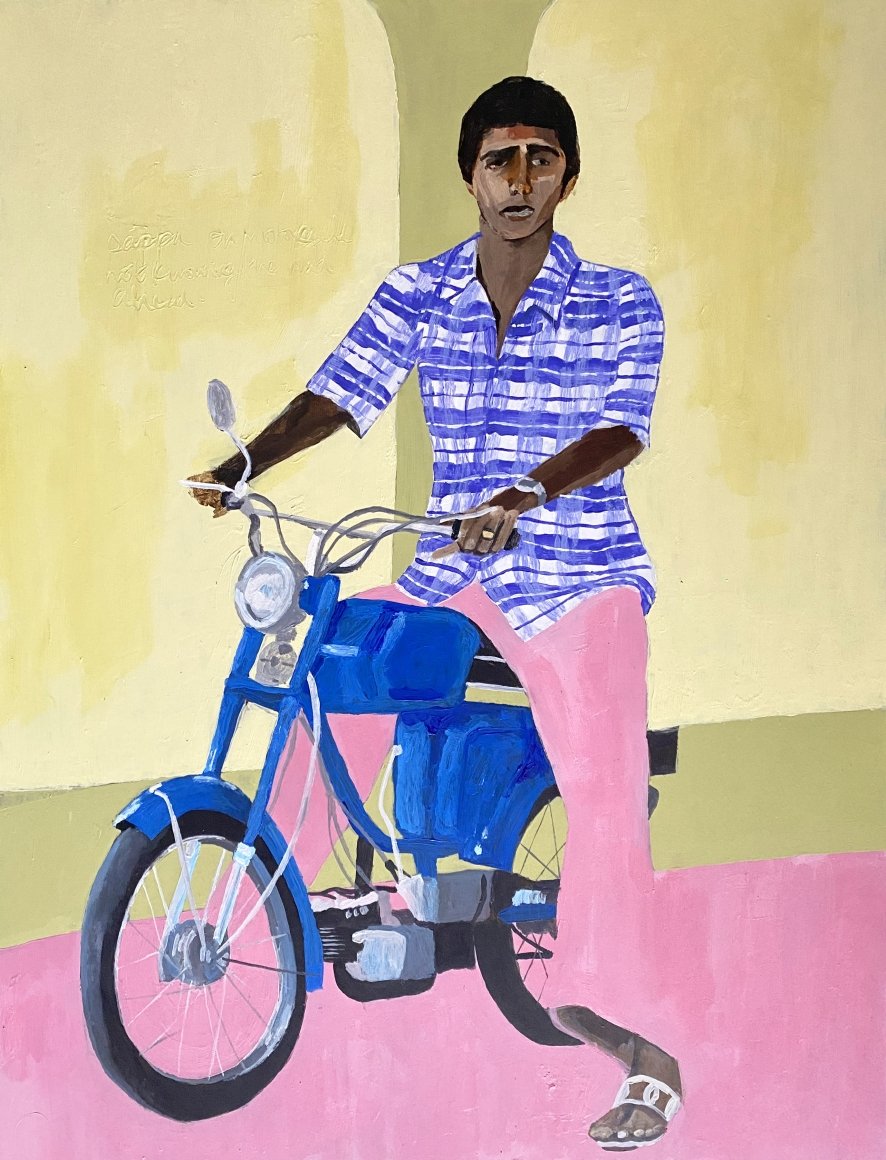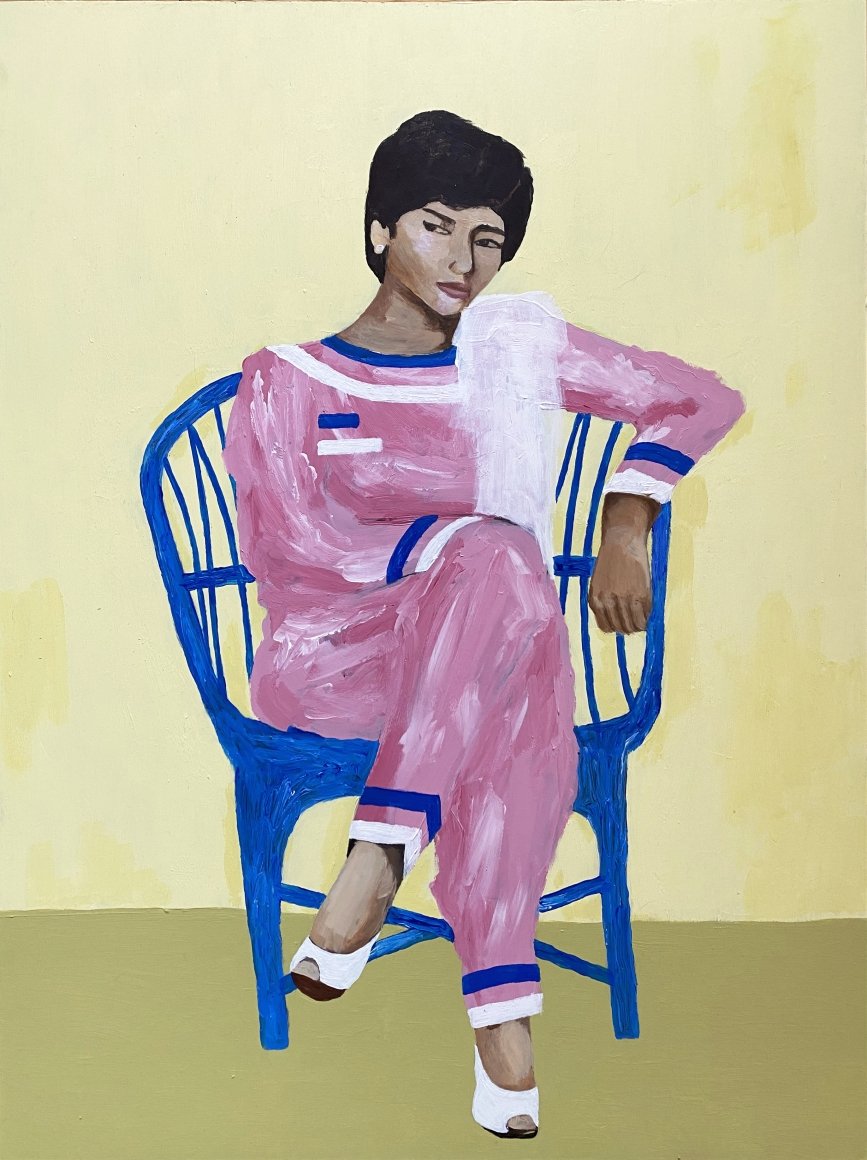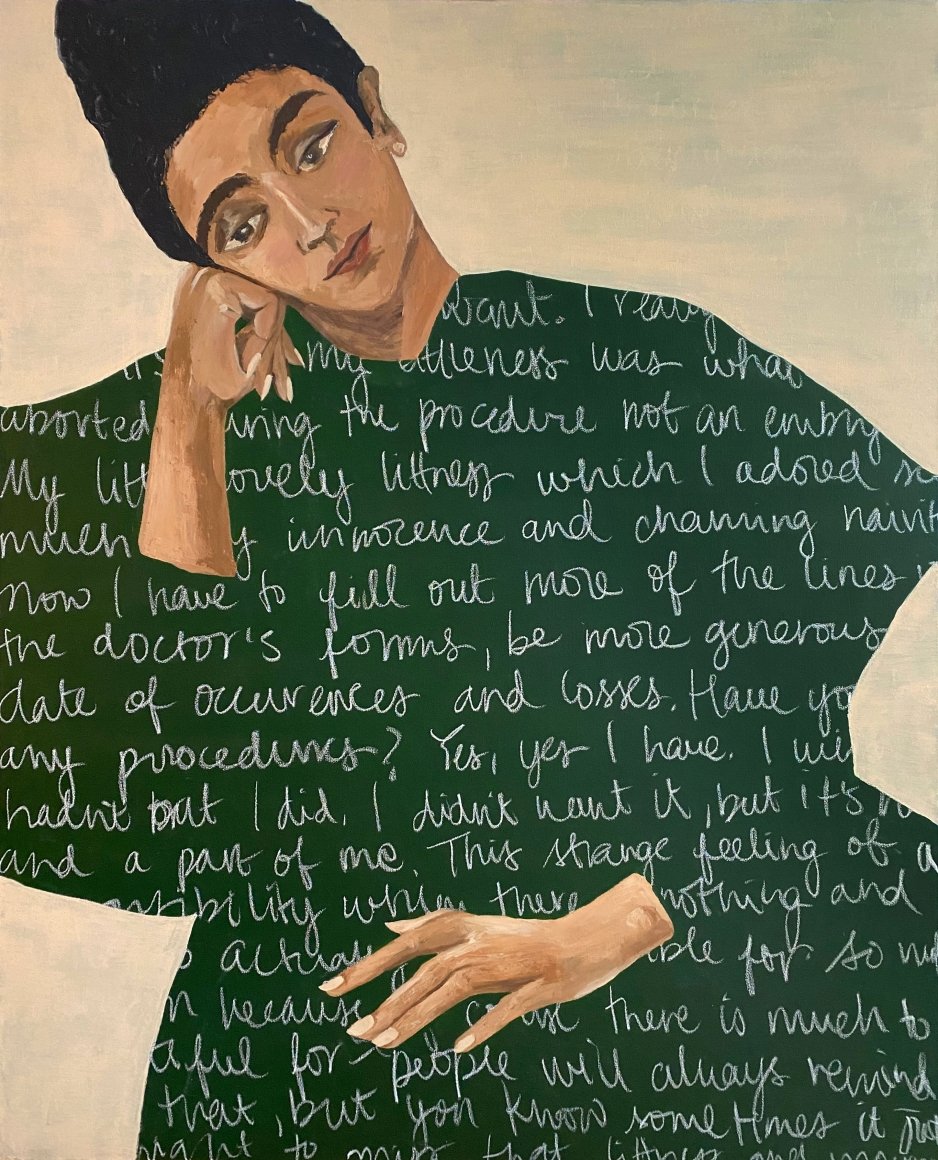In Conversation with Maya Varadaraj
/mAYA vARADARAJ, six little descendants, 2022, acrylic on panels
We’ve long admired Maya Varadaraj’s life-sized portraits that she paints on raw linen canvases. She is drawn to old photographs of her family and moments of growing up in Coimbatore, not just for composition, but for connection — revisiting the gestures, clothing, and textures of her past to reflect on memory and identity. Somehow, the figures feel strangely familiar.
After reading a delightful interview with Maya on Artnet, where she talks about a typical workday at her home studio in New York and how she has the Harry Potter movies just playing on repeat in the background while painting, we wanted to hear more. We talk to her over email about her latest work, the materials she’s drawn to, and the quiet rituals that shape her art practice.
Maya Varadaraj. Image courtesy of The Wassaic Project
What does a typical day in your studio look like?
Fairly structured and steady I would say. I usually have a goal for days in the studio and it helps my productivity. I work to the TV playing in the background or true crime podcasts; it helps me keep pace, without looking at the time. I also get easily distracted so listening to something helps me focus.
You’ve been working on large-scale portraits for a while now. What continues to draw you to that scale—and what does it allow you to do that smaller works don’t?
The process behind making large-scale work and small-scale work is very different. It is a lot more intimidating to work on large-scale portraits. I approach large canvases with a lot more respect, knowing that I’m going to be challenged with proportions, expressions, and texture. Every time I make a large painting, I learn something new about my process and how to refine it. I definitely enjoy it, but I also really love making small-scale work – I feel like I can be a little more playful with smaller works.
Maya Varadaraj in her Studio. Photograph by Armani Prosper
How has your relationship with painting evolved through your work in collage and other mediums?
Working in collage, installation, and ceramics has really informed the way I paint, in terms of process, aesthetic, and concept. All my collages are very clean and minimal; I play with negative space a lot and that’s something that I continue to do in painting. I learnt how to be grounded with the source materials through collage and installation, and that makes working with family photographs more meaningful. Ceramics really taught me to go with the flow, this is something that I’m still trying to learn with painting.
Maya Varadaraj, IT WAS ALL TOUCH AND GO FOR A WHILE, 2020, Collage
Maya Varadaraj, CIRCLING BACK, 2020, Collage
You’ve spoken about balancing the societal and the personal in your work—where do you find yourself in that conversation now?
They are part and parcel of each other. I find that society is reflected in my family photographs and therefore paintings; the hairstyles, the fashion, the expressions, the relationships, and the surroundings. It has been lovely to have conversations with people about how my relatives resemble their own, or how they remember those specific hairstyles being trendy.
“The first large portrait I made was this one. My beautiful grandmother, Srivalli. Here she’s wearing a fur coat over an elegant sari, showing off the angles of her face in a photo booth.
I remember my grandmother as a delicate, kind woman who gave me sweets when I came back home from primary school. This was before her memory retreated so deep into her mind, and she began living with strangers. Familiar strangers who wanted hugs and sweets when they returned from school.
Painting my grandmother brought her back to me. For me these paintings are not portraits but conversations with my ancestry - we speak to each other through recalled memories and stories. I began each portrait with a letter. In the letter to my grandmother I reminded her of who she was to me, and thanked her for two of the most important women in my life. ”
Your work often explores the familial, and intergenerational stories and connections. Has this changed after your experience of new-parenthood?
I am so much more aware of what my history and my narrative is and how I want to preserve it for my kids. I’ve been thinking a lot about the food that I grew up eating, and how I don’t have the recipes for a lot of things that I frequently ate. I feel a responsibility to record these memories and experiences. Not just my own but my parents’, and how I can preserve their memories, stories, and recipes so that my kids know where they come from. I record visually, so I feel like my work will become another form of preservation.
Pappai, The Wine Is Getting Warm, 2023, Acrylic on Canvas
“For the first six years of my life, I lived in my grandparents house. It was the same house my mother and aunt grew up in - “Periyabangala”.
Here my aunt and my grandmother are sharing an evening together. My aunt on the phone - as she usually is - and my grandmother indulging in her nervous ticks.
I know this nook all too well - having seen the iterations of phones installed - rotary, answering machine, cordless, till the nook ceased to exist as did landlines.
I used to hide in this nook during dinner parties. Oozing with shyness to greet guests. If I close my eyes I can still feel the cool terrazzo tiles beneath my feet, and the rounded smell of dark.”
Maya Varadaraj, Portrait of Achilles Heal , 2023, Acrylic on Linen
“Painting my Achi, my father’s mother, was not easy. Perhaps because I wish I knew her better than I did.
To me my Achi was a serious woman, devoted to her religious beliefs, and charity work. She didn’t have patience for unruly girls with wild curly hair that could be shed into dishes she carefully prepared.
There’s a story of my Achi as a young girl that I’m fond of - she rode a buffalo away from school and wasn’t found for several hours. I’ve never got a straight answer from any of my family as to why or how. It would be nice to have known that unruly girl.
One person from every generation of my father’s family has “run away”. My Achi, followed by my father, followed by my cousin, Vikram. We’re waiting for the next generation of members to follow suit.”
Maya Varadaraj, Tha Tha And Tha Tha Making Jokes On The Hillside, 2022, Acrylic on Canvas
Your family’s ties to the cotton and textile industry feel closely woven into the way you paint clothes and patterns—how do these connections inform your paintings?
Clothes are another way for me to engage the viewer as well as the subject that I am painting. Textiles are ingrained in my family history and an important way in which I disseminate feeling and memory. When I paint clothes solid, and flat; these evoke moments of pause and self reflection. For me, it is a way to enter the painting with moments that feel familiar but not exact. Other times I paint clothing with heavy texture, it feels blurry and rippled like a memory. In these moments, the texture takes me back to that precise instant urging me to recall more details of clothes, smells, and sounds.
Maya Varadaraj, Jay in Pink, Not Knowing The Road Ahead, 2022, Acrylic on PaneL
Maya Varadaraj, Judgmental Jai With A Fresh Coimbatore Bob Cut, 2022, Acrylic on Panel
You wrote letters to your subjects before painting them and have previously spoken of how the process of writing “offered an emotional extrapolation of each image and its significance.” Do you still find yourself interested in this form of intermodality in your work, and if yes, how so?
Writing is an important part of my work, it always has been. I write to recall memories and then those details become visual. In some cases I incorporate the writing in the work either in the subject’s clothes that’s partly visible or as the underpainting that no one sees.
Maya Varadaraj, In Green and Naivete, 2022, Acrylic and Oil Pastel on Canvas
Is it true that Rilke's letters had an influence on the letters you wrote?
I was reading Rilke’s “Letter’s To A Young Poet” - letters Rilke wrote to a young poet, Franz Zaver Kappus who was asking for his advice. I wanted to reengage with letter writing after this, as it was a large part of my childhood in a boarding school. The letters were also comforting to my own creative process, as if the advice was being shared with me as I developed this body of work.
What’s currently shaping your interests—both in terms of subject and medium?
I’m continuing to collect stories, photographs, objects and memories from my family to build my archive. I’m very excited about this, because the more information I have, the more robust my work becomes.
Maya Varadaraj, Adequate and Suitable, 2022, Acrylic on Canvas
Biography
Maya Varadaraj’s work draws on South Asian material culture to explore and reframe representations of femininity. Her visual language pulls from the everyday—vintage ads, calendar illustrations, and painted studio portraits—reworking these familiar forms into something both intimate and quietly subversive.
She trained in apparel design at the Rhode Island School of Design and went on to complete a Master’s at the School of the Art Institute of Chicago. Maya’s work has shown at Vitra Design Museum, Museo del Disseny in Barcelona, Salone del Mobile, Mana Contemporary in New Jersey, and Assembly Room in New York. Originally from Coimbatore, she now lives and works in New York City.
Follow Maya's work @maya_vara














